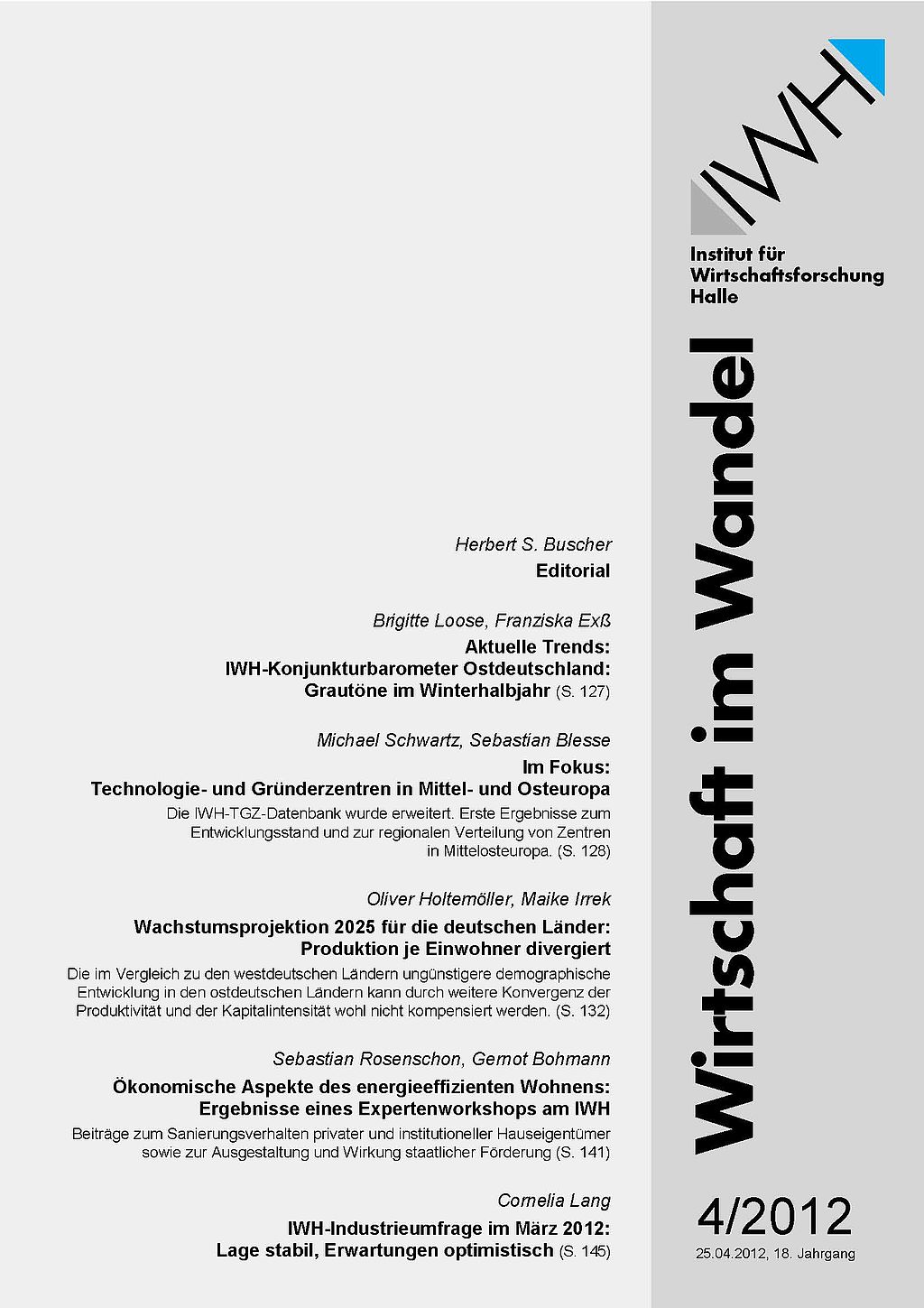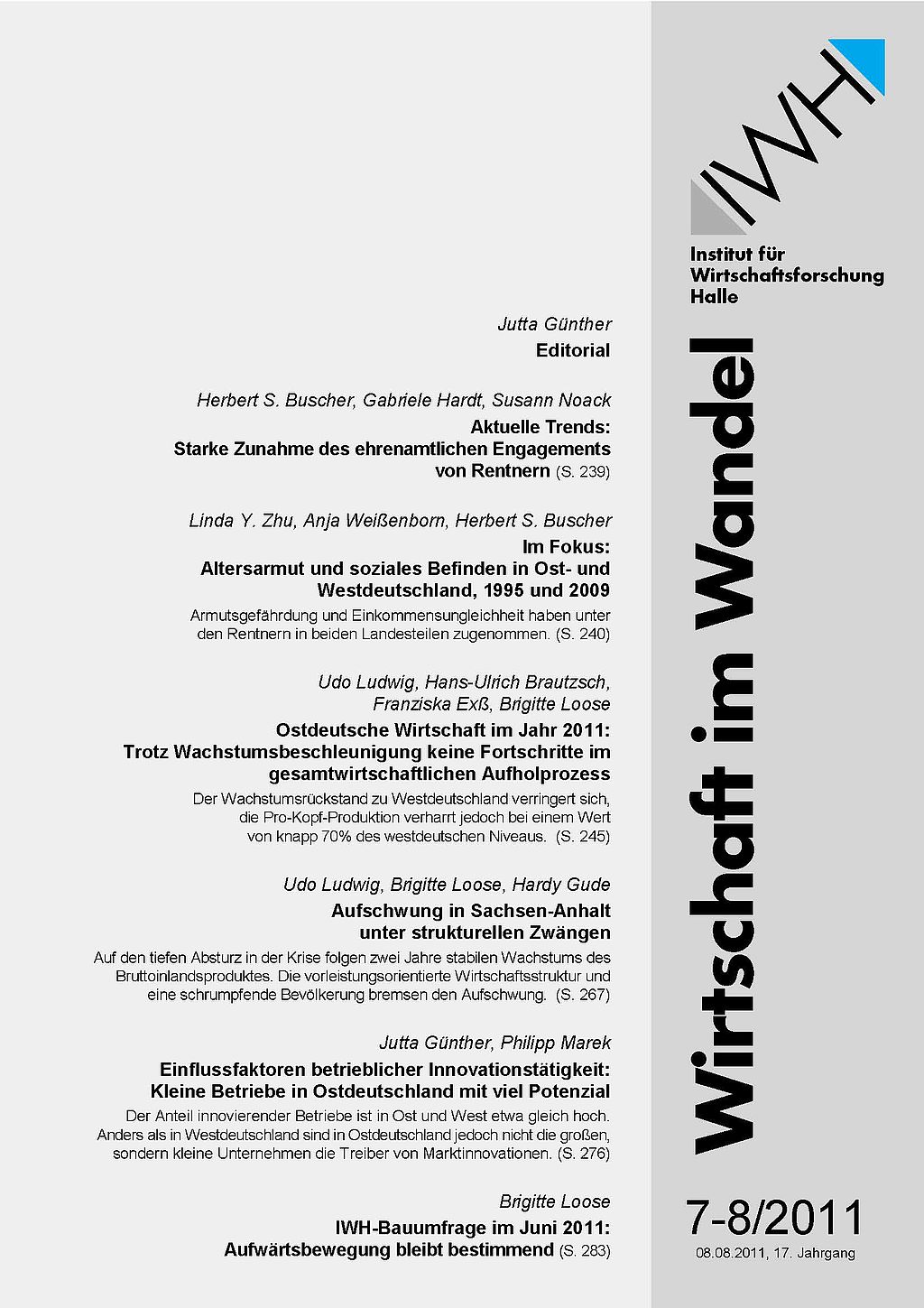Demographic Change
Dossier

In a nutshell
Many thousands of refugees flocked to EU member states in 2015 and 2016, especially to Germany. As has been widely and controversially discussed. The much more serious and longer-term problem of demographic change has been adeptly sidestepped, however. Although it may sound unpopular to some: immigration is vital for Germany, as there is no other way to offset demographic change. This is because the population is constantly ageing and neither the labour market, municipal infrastructure investments, nor the German pension system are currently adequately prepared.
Our Expert

President
If you have any further questions please contact me.
+49 345 7753-700 Request per E-MailAll experts, press releases, publications and events on "Demographic Change"
Europe's century-long task
The increasingly ageing population is already high on the political agenda and will pose a major challenge for the next generation. If things remain as they are, today's children will have to pay much higher pension contributions than their parents and grandparents – and receive considerably less money in return when they are old. Although demographic change is considered when adjusting pensions, this is not sufficient to prevent the scenario just described. There are certainly alternatives, however, to the existing system. For instance, pension levels at retirement age could be fixed at current levels, or even slightly higher, and the pensions of those who have already retired only be increased in line with inflation. Living standards would therefore be maintained. On the other hand, people's work-life balance must be improved, so that couples are not afraid to have children. Almost 10 years ago, the IWH determined that women only continue to work part time after having children, particularly in western Germany.
Germany's towns are also paying too little attention to demographic change and thus the future. They primarily make investments based on the current financial situation and too little on how the population will develop in future. If towns continue to do this, some will be chronically under-funded and others over-funded in 20 years' time.
Another problem is the shortage of skilled workers. In order to make it attractive for well-trained specialists to move to Germany from overseas, a targeted immigration policy is required. The projects launched to date, such as Blue Card, have not been as successful as hoped. So Germany currently remains isolated from the international pool of highly-qualified workers. A points-based system could be a promising alternative.
At the same time, Germany is facing the huge humanitarian dilemma of refugees; the enormous wave of migration since 2015 is placing considerable demands on Europe. The asylum system in Europe still has major shortcomings. A coherent European asylum policy is currently more important than ever, but the refugees have been very unevenly distributed within Europe. The IWH mooted a strategy for their equitable distribution back in 2015, which takes into account both the allocation of people and the costs.
In addition, the state must sustainably manage the integration of newcomers into our culture and labour market. This also includes improving social mobility within our society, in order to provide immigrants with good training opportunities. "Germany has been asleep for the last ten years. We have not seriously considered how we will handle our population development in 15 years' time," says Reint Gropp, President of the IWH in an interview with Mitteldeutsche Zeitung.
Despite the intake of 1.2m refugees over the past two years, Germany’s population suffers a serious decline. Especially in Eastern Germany total population shrinks. According to the OECD, about half of asylum-seekers who started off in eastern Germany in the past moved to places such as Hamburg once they secured their permit.
Whether and how this country can make economic use of the opportunities presented by immigration is currently still under discussion. Integration is a fundamental part of this debate. Due to the complexity of the issue, an interdisciplinary, scientific approach, such as that of the ‘Crises of a globalised world’ Research Group, is essential, in order to understand the reciprocal mechanisms and dynamics. For example, analyses by the IWH show that measures to cope with immigration during late 2015 triggered additional economic impetus. National and regional governments increased their budgets, while spending on housing, food, medical care and general support for refugees fuelled demand and production, especially in the construction and hospitality sectors, as well as in professional services. According to calculations by the Joint Economic Forecast Project Group, migration-related expenditure across Germany contributed 0.1 percent to the growth in gross domestic product in 2015.
Today, one in 113 people in the world is considered to be a refugee – 65 million in total. In order to resolve the complex ‘asylum’ problem, politicians need to be much better organised and ideally develop collective actions. This is the only way to achieve a solution that is as efficient as possible – and above all humanitarian.
Demographic change is profoundly affecting various social spheres, yet is still underestimated by politicians and citizens. Pensions, future investments, migration – all these things are having a direct, immediate impact on people in Germany. Which is precisely why timely, sustainable solutions are required that do not simply pay lip service to sustainability.
Publications on "Demographic Change"

Sweden’s Policy for Guaranteeing Service Provision Based on the Example of Jämtland
in: Europa Regional, No. -1, 2012
Abstract
The northern Swedish Jämtland county is among the most sparsely populated regions in Europe. Due to its rural/peripheral character and a dispersive settlement structure, it is particularly called upon to maintain adequate service provision. An empirical study analysed the provisions of services of general interest for children and elderly persons and adult education in the Country of Jämtland to discover how the various types of services of general interest are organised in this area, what effect the demographic change has on the provision of these services and whether any adjustment processes can be observed. It became apparent that the local players have a clear awareness of the problems related to the demographic change, although to date one cannot speak of explicit adjustment processes.

Wachstumsprojektion 2025 für die deutschen Länder: Produktion je Einwohner divergiert
in: Wirtschaft im Wandel, No. 4, 2012
Abstract
Viele ökonomische Entscheidungen basieren implizit oder explizit auf Projektionen der wirtschaftlichen Aktivität in einem Land oder einer Region. In diesem Artikel wird ein langfristiges Projektionsmodell für Deutschland insgesamt und die deutschen Länder vorgestellt, das am IWH entwickelt worden ist. Das Modell beruht auf einer gesamtwirtschaftlichen Produktionsfunktion; die Produktionsfaktoren Arbeit und Kapital sowie die Produktivität werden mit Zeitreihenmodellen fortgeschrieben. Die wirtschaftliche Entwicklung in Deutschland insgesamt wird in die Teilmodelle für die Länder integriert, und die Annäherung der einzelnen Länder an den Bundestrend wird mit ökonometrischen Verfahren geschätzt. Mit Hilfe des Modells wird eine Projektion der wirtschaftlichen Aktivität in Deutschland insgesamt und in den Ländern bis zum Jahr 2025 vorgenommen. Ein wichtiges Resultat ist, dass die ungünstigere demographische Entwicklung in den ostdeutschen Ländern wohl nicht durch weitere Konvergenz der Produktivität und der Kapitalintensität kompensiert werden kann, sodass die Produktion je Einwohner in den ostdeutschen Ländern schwächer zunehmen dürfte als in den westdeutschen Ländern. Zwar verläuft die Entwicklung auch in den westdeutschen Ländern heterogen, es dürfte aber im Gegensatz zu den ostdeutschen Flächenländern in keinem westdeutschen Land mit heute unterdurchschnittlicher Produktion je Einwohner zu einer spürbaren Vergrößerung des Abstandes zum Bundesdurchschnitt kommen.

Old Age Poverty and Satisfaction with Living Conditions in East and West Germany, 1995 and 2009
in: Wirtschaft im Wandel, No. 7, 2011
Abstract
The current contribution presents poverty indicators for West and East Germany for the years 1995 and 2009. The analysis is based on the two corresponding waves of the GSOEP. We only consider households with at least one senior citizen aged 65 or above. Furthermore, we distinguish between male and female pensioners. In the first part the weighted equivalized household income is calculated as well as various statistical measures such as the 20%- and 80%-percentile, the 80/20-ratio and the 90/10-ratio of the income distribution of senior citizen households. In an additional step we also present and discuss the main sources of income such households have. In the second part of the contribution we focus on social indicators with respect to the satisfaction with income and the current living conditions as well as the expected situation in five years. As the results show, old age poverty has increased in both parts in Germany with East German women being an exception. With respect to the future, most elder people look optimistically into the future.

Ageing and Labour Markets: An Analysis on the effect of worker’s age on productivity, innovation and mobility
in: Technische Universität Dresden. Dissertation, 2011
Abstract
The present study analyses the labour market effect of workers’ ageing. Explicitly, the impact of age on productivity and wages, on innovation as well as on mobility is explored empirically. The econometric analyses are based on firm and employment data from the Institute for Employment Research (IAB) and, thus, refer to the labour market of Germany. Regarding the productivity and wage effects of age the econometric results confirm a positive correlation between firm productivity and the share of middle-aged employees (41-50 years old) within the manufacturing sector. Hence, the results provide evidence of an inverted u-shaped age-productivity profile in this sector also found for other countries. Furthermore, age-wage and age-productivity profiles seem to follow unequal patterns. Compared to the group of the 15-30 and the 51 and above years old workers the group of middle-aged employees earn less than a productivity based wage scheme would require. In terms of age effects on innovativeness the micro-econometric analysis again reveals an inverted u-shaped profile. Workers aged around 40 years seem to act as key driver for innovation activities within firms. An additional finding concerns the impact of age diversity on innovation. The expected positive effect of a heterogeneous age structure is not confirmed by the data. With respect to labour market mobility results are in favour of a negative correlation between age and job mobility either in terms of changing professions or firms. The estimation of a multi equation model verifies that expected wages of older workers do not or only marginally increase due to job mobility, so, financial incentives to change jobs are very low. Yet, even after controlling the absent wage incentive older employees still remain more immobile than younger workers. Altogether, these results should not only be of academic interest but also informative for actors on the firm and the governmental level. Both sides are asked to cope with the challenges of demographic change. Only by maintaining productivity and innovativeness until old ages the necessary resources can be generated to preserve an economy’s prosperity even if the share of non-active population is increasing by demographic developments. Secondly, enhancing productivity is essential to ensure employability of older persons and to sustain the size of workforce even in the circumstances of an ageing economy.

Demographischer Wandel und technische Infrastruktur: Wer soll die Kosten tragen? Eine Untersuchung am Beispiel ostdeutscher Mittelstädte
2010
Abstract
Eine Folge des – nicht nur in Ostdeutschland zu beobachtenden – demographischen Wandels in Form von Bevölkerungsrückgang ist, dass bei bestimmten Netzinfrastrukturen immer weniger Bürger die Kosten für den Bestand und weiteren Ausbau der Netzinfrastrukturen tragen müssen. Ein zentrales Charakteristikum dieser Infrastrukturarten ist nämlich ihre hohe Umbauresistenz, d. h. Anpassungen sind schwierig, und somit lassen sich Kostensteigerungen kaum abmildern. Veränderungen der Bevölkerungszahlen, der Trinkwassernachfrage und deren räumlicher Verteilung müssen jedoch langfristig Berücksichtigung finden. Es stellt sich daher die Frage, ob und inwieweit verschiedene staatliche Planungsebenen – Regionalplanung, Kommunalplanung, Ver- und Entsorgungsplanung etc. – mehr oder weniger Einfluss auf diese Kostenentwicklung nehmen können. Die Studie untersucht anhand langfristiger Entwicklungsszenarien die Einflussmöglichkeiten der Stadtplanung auf die Infrastrukturfolgekosten. Am Beispiel von drei ostdeutschen Mittelstädten wurden die erwarteten Kostenverläufe für die technische Infrastruktur (Trinkwasser- und Abwassernetz sowie die Gemeindestraßen) bis 2030 geschätzt. Ausgewählt wurden Städte in Sachsen und Sachsen-Anhalt mit einer deutlich negativen Bevölkerungsprognose.



